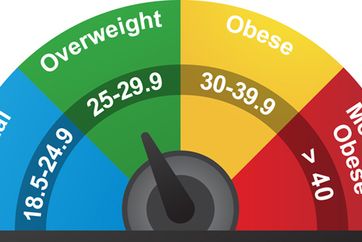Increased susceptibility to fatigue 94% more likely in older adults with obesity
Developing and maintaining obesity into older age can lead to large increases in fatigability measures, according to findings published in Obesity.

“The development and validation of the construct of perceived fatigability in the gerontological literature assess fatigue in relation to a standardized physical task, thus gauging the individual’s perception of physical fatigability,” Pablo Martinez-Amezcua, MD, MHS, of the department of epidemiology at Johns Hopkins Bloomberg School of Public Health, and colleagues wrote. “A better understanding of perceived fatigability and the primary contributors to its development and progression may present new opportunities to reduce its detrimental effects on health and quality of life with aging.”
Martinez-Amezcua and colleagues analyzed data from 1,054 adults (mean age, 70.4 years; 51.6% women; mean BMI, 27.2 kg/m2) from the Baltimore Longitudinal Study of Aging. Although the study began in 1958, Martinez-Amezcua and colleagues worked with participants who had measures of abdominal visceral fat, subcutaneous fat and waist and hip circumferences collected between 2007 and 2015. BMI and fat mass were also calculated at this time, and participants also rated their “perceived fatigability” on the Borg Rating of Perceived Exertion scale after a 5-minute walk on a treadmill. The scale ranges from 6 to 20 with higher marks indicating more fatigability.
The researchers reported that fatigability scores were higher for those with obesity or a BMI of at least 30 kg/m2, who made up 24.5% of the total cohort, compared with those with normal weight or a BMI between 18.5 kg/m2 and 24.9 kg/m2, who made up 35.6% of the total cohort (P < .001). In addition, when compared with someone with normal weight, it was 94% more likely that someone with obesity would have increased fatigability (OR = 1.94; 95% CI, 1.28-2.91), the researchers reported. Participants were also 7% more likely to have elevated fatigability scores with each BMI increase of 1 kg/m2 (OR = 1.07; 95% CI, 1.03-1.11).

“These findings indicate that the relationship between BMI and fatigability is nonlinear and suggest that small increments of weight gain may be more detrimental among those who already have overweight or obesity,” the researchers wrote. “This may be an indication of biomechanical or metabolic inefficiencies that contribute to higher energy costs for mobility and/or lower physical activity for those with greater adiposity, inducing a cycle of higher fatigability, low activity and further weight gain.”
Beyond BMI, the researchers found that increased fatigability was 0.2% more likely for each 1 cm2 of added subcutaneous fat (OR = 1.002; 95% CI, 1-1.005) and that higher waist circumference (OR = 1.02; 95% CI, 1.01-1.04), hip circumference (OR = 1.04; 95% CI, 1.02-1.05) and waist-to-height ratio (OR = 1.42; 95% CI, 1.12-1.79) all increased the odds for higher fatigability. Those odds doubled compared with someone with normal weight when a participant had both obesity and a larger waist circumference (OR = 2.13; 95% CI, 1.39-3.27).
“As fatigue and fatigability are common in mid- to late life, it is essential to identify potentially modifiable risk factors, amenable for intervention that may delay declines in physical function and physical activity, that lead to disability and poor quality of life,” the researchers wrote. “These associations were strongest among those aged 65 or older, suggesting that weight management during midlife ... may be an effective target for curbing fatigability and maintaining quality of life in older age.” – by Phil Neuffer
Disclosures: The authors report no relevant financial disclosures.
